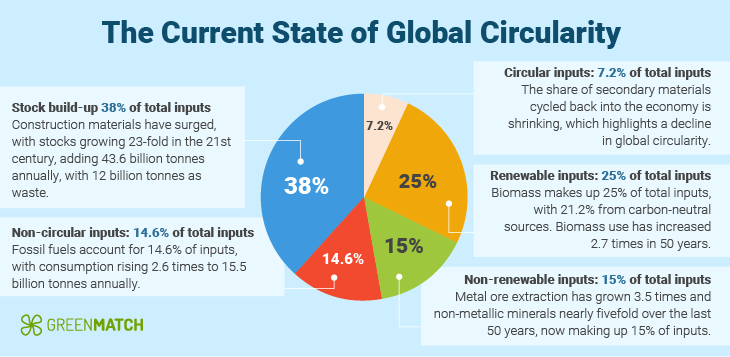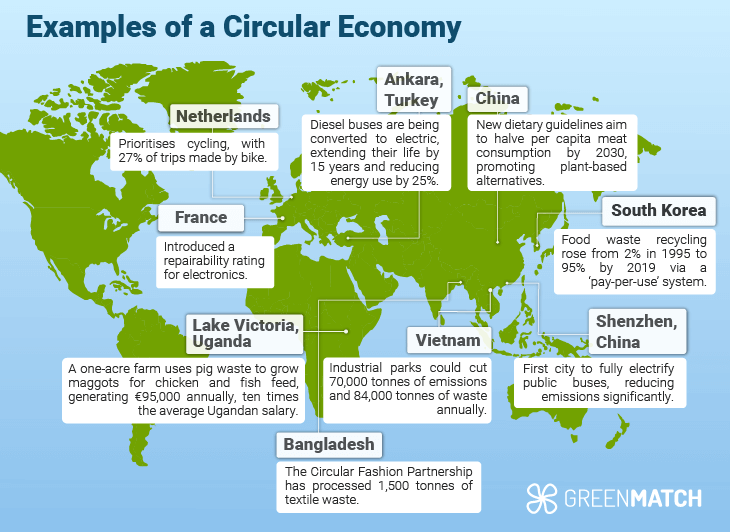- GreenMatch
- Environmental Impact of a Circular Economy
Can a Circular Economy Help Us Achieve Sustainability? Statistics, Trends, and Facts


- Global circularity has decreased from 9.1% in 2018 to 7.2% in 2023, a 21% drop over five years.
- Total material extraction is on the rise, more than tripling since 1970 and almost doubling since 2000, bringing it up to 100 billion tonnes today.
- A circular economy must be integrated at all levels of production, industry, and consumption, with active support and collaboration from both communities and governments.
At its core, a circular economy focuses on minimising waste by continuously reintroducing reusable materials back into the production cycle.
While the term has gained popularity in business circles, its true meaning and impact often need to be clarified. This could be because, in some contexts, the circular economy is seen as overly optimistic—unlikely to drive sustainability at the urgent pace required.
In this article, we’ll explain what a circular economy is, how it functions, its potential for success, and the key challenges that may hinder its progress.
What Is Meant by a Circular Economy?
A circular economy typically refers to extending the lifetime of the materials used to manufacture products by reusing them beyond the end of the product's life.
The circular economy is a model of production and consumption that involves sharing, leasing, reusing, repairing, refurbishing, and recycling existing materials and products as long as possible. In this way, the life cycle of products is extended.
European Parliament
Products in a circular economy should be designed, produced, consumed, and disposed of with the intention of being reintroduced into the economy for reuse, repair, or recycling.
A circular economy is beneficial on many fronts. It prevents natural habitat loss, reduces production and consumption waste, and promotes efficient use of natural resources. What's more, it fosters greater equity and shared prosperity across all sectors of society and the economy.
Compared to today's linear economy, which follows a take-make-use-dispose pattern, adopting a collective circular economy becomes critical for creating long-term sustainability and minimising environmental impact.
Our linear economy is inherently unsustainable because it promotes overreliance on easily accessible, low-cost materials and energy, which leads to resource depletion and environmental degradation.

Source: European Parliament
Environmental Impact of a Circular Economy
A transition to a circular economy is often proposed as a solution to mitigate the harmful impacts of our current linear production model. Some of these negative effects include natural habitat loss, excessive amounts of waste, and climate change.
For this shift to be effective, a circular economy must be integrated at all levels of production, industry, and consumption, with active support and collaboration from both communities and governments.
This sustainable development establishes long-term social, economic and environmental benefits that future generations can enjoy well into the future. Let's take a closer look at some of these benefits:
Environmental benefits
Reduces waste
Too many of the everyday products we consume are designed for single use and end up in landfills. This wastefulness releases harmful pollutants such as carbon monoxide and greenhouse emissions such as methane. A circular economy prevents excessive waste through a system of reusing and recycling.
Conserves raw materials and natural resources
In a circular economy, valuable natural resources, such as metals, minerals and fossil fuels, are conserved thanks to the reusing of materials and emphasising product longevity. This reduces excessive mining, material extraction, and deforestation, which prevents natural habitat loss and environmental degradation.
Economic benefits
Creates new business opportunities
A circular economy encourages businesses to foster an industry focused on repair, remanufacturing, recycling, and product innovation. This leads to the development of new business models and job creation in sectors like waste management, eco-design, and renewable energy.
Encourages innovation
The circular economy drives innovation by challenging businesses to design durable products that are modular and easier to repair or recycle. This pushes industries to explore sustainable technologies and develop more efficient production processes. This then contributes to long-term competitiveness and resilience.
Reduces cost of raw materials
Businesses can lower their dependence on expensive virgin resources, which reduces material costs, improves supply chain stability, and makes production more economically viable, especially in the face of resource scarcity.
Social benefits
Improves product quality
A circular economy encourages the development of higher-quality, longer-lasting products. These let consumers enjoy durable goods that require fewer replacements, improving trust and satisfaction across our goods and services.
Improves human health
By reducing waste and pollution, a circular economy contributes to cleaner air, water, and soil, leading to healthier living environments. Additionally, the reduced use of harmful chemicals and materials in production processes lowers exposure to toxic substances.
Why Is a Transition to a Circular Economy Necessary?
Many of today's pressing environmental challenges can be traced back to our linear economy. These include natural habitat loss, resource scarcity, waste from unsustainable production and consumption patterns, plastic in oceans, and health concerns due to increasing amounts of waste.
According to The Circularity Gap Report, total material extraction is actually on the rise, more than tripling since 1970 and almost doubling since 2000, bringing it up to 100 billion tonnes today. Virgin material use is expected to reach 190 billion tonnes by 2060.
The linear model has been found to design products with a limited lifespan in mind, encouraging consumers to buy them again.
As of 2023, the global economy has seen a significant decline in circularity, with just 7.2% of material inputs being recycled back into the economy, down from 9.1% in the past five years, the report finds.
The global prevalence of these positions our linear economy as a large and critical societal challenge to overcome in itself.
This reflects a troubling trend toward greater resource depletion and environmental impact. Here's a snapshot of the current state:

Source: The Circularity Gap Report
How to Transition to a Circular Economy
The case for a circular economy is clear, but what does the transition to one look like? According to The Circularity Gap Report, four key strategies will be integral to ensuring the aims of a circular economy can be achieved.
Narrow: Use less
This refers to using less on a macro scale, such as through the phasing out of fossil fuels, and on a micro, individual basis, such as cutting down on the meat in our diets and opting to ride a bike rather than driving a car. In 2023, the threshold for sustainable consumption, 8 tonnes per person, was surpassed by 1.5 times.
Slow: Use longer
Slow strategies keep materials in use for as long as possible. This means improving the design of materials, products, and infrastructure so they are built with repairability in mind and made from materials that are made to last.
Regenerate: Make clean
This component would mean phasing out any toxic or hazardous materials and processes and replacing them with regenerative ones. This could be done by designing new regenerative processes or switching from synthetic to organic fertilisers, for example.
Cycle: Use again
This maximises the volume of secondary materials that are recycled and reused back into the economy. This minimises the need for new virgin materials and limits their use to when they are necessary, such as through the blending with a re-used material to maintain its durability.
With these strategies in mind, some key sectors will have to transform to establish and uphold a new circular economy. Here are some of the most important industries that will help bring about the transition:
Construction
The construction industry, together with rapid urbanisation, generates vast amounts of waste from building and demolition activities. It contributes significantly to environmental degradation, including land system changes, water stress, and nearly one-third of global energy consumption. Materials like concrete, steel, and plastics are extracted at unsustainable rates, while buildings are major carbon emitters during and after construction.
Solutions: Energy-efficient designs and urban planning are essential to transitioning to a circular economy. Reusing existing structures, prioritising circular materials, and minimising construction waste can greatly reduce resource use and emissions, while smart planning reduces urban sprawl and its environmental impact.
Food and Organic Waste
The food system is the largest driver of land-use change, water consumption, and biodiversity loss while also contributing significantly to climate change. Rising incomes and population growth increase demand for food, leading to waste and inefficiency at every stage, from production to disposal. In particular, meat production and consumption accelerate environmental damage.
Solutions: A circular economy in food involves minimising food waste, adopting regenerative agriculture practices, and promoting local, seasonal, and organic consumption. By closing the loop on organic waste through composting and biowaste recycling, we can create nutrient-rich materials for farming, reducing dependency on synthetic fertilisers and limiting waste.
Packaging and Plastics
Plastics have become a cornerstone of modern life but are highly wasteful, with low recycling rates and significant environmental impacts. Globally, plastic production and incineration emit 400 million tonnes of CO2 annually, and plastic consumption is expected to double in the next 20 years, which only causes pollution and public health risks.
Solutions: A circular approach reduces plastic use, improving recycling systems and incorporating recycled materials into new products. Regulations requiring recycled content and incentivising better product design can drastically reduce plastic waste and emissions, which will help foster more sustainable consumption and manufacturing patterns.
Textiles
The textile industry, largely linear, generates enormous waste. Up to 90% of discarded textiles currently end up in landfills despite their recyclability. Fast fashion exacerbates this by encouraging short-term use and disposal, contributing to massive resource depletion and pollution.
Solutions: A circular textile economy incorporates recycling, reuse, and sustainable production. Strategies include extending product lifecycles, promoting second-hand markets, and adopting sustainable materials. New business models, like clothing rental and repair services, help shift consumption patterns toward more responsible, circular habits.
Electronics and ICT
Electronics contribute significantly to resource depletion and hazardous waste. The current linear model lets valuable materials be discarded due to non-repairable designs, software obsolescence, or lack of recycling infrastructure. This causes environmental harm and missed opportunities for material recovery.
Solutions: Circularity in electronics involves designing products for longevity, repairability, and recyclability. Policies promoting modular designs, extended warranties, and improved recycling can minimise waste and recover critical materials like metals. This reduces the need for new mining and limits the environmental and social impacts of resource extraction.
Energy
The energy sector, still heavily reliant on fossil fuels, drives climate change and contributes to nearly 75% of global greenhouse gas emissions. Current linear energy systems could be more efficient and generate vast amounts of waste; meanwhile, the adoption of renewable energy could be faster.
Solutions: A circular energy system focuses on energy efficiency, integrating renewable energy sources, and transitioning to decentralised grids. Waste-to-energy solutions can repurpose organic and industrial waste into usable energy, reducing both emissions and resource extraction. Engaging citizens in energy-saving practices is also key to ensuring a sustainable future.
Transport
The transport sector is one of the largest consumers of fossil fuels, contributing around 25% of global CO2 emissions. It also drives land-use changes, habitat fragmentation, and ocean acidification. The growing demand for transport, especially road and air travel, further increases emissions and environmental pressure.
Solutions: A circular transport system would prioritise low-emission vehicles, public transit, and infrastructure designed for reuse and minimal environmental impact. Shifting toward electric and shared mobility, combined with improved vehicle durability and part recycling, can help reduce transport's ecological impact.
Manufactured Goods and Consumables
Manufactured goods, particularly industrial products, are responsible for 24% of global greenhouse gas emissions in 2019 and a significant portion of global waste. The extraction of materials like metals has devastating environmental and social impacts, and inefficient industrial processes generate vast amounts of waste.
Solutions: Circular manufacturing reduces resource use by designing for durability, repair, and recycling. Innovations like waste heat recovery, resource-efficient production methods, and closed-loop systems can dramatically cut emissions and resource extraction, promoting sustainability across the entire industrial lifecycle.
Examples of a Circular Economy
The map below shows some examples of how a circular economy looks in various international contexts.

Source: The Circularity Gap Report
Statistics, Facts and Figures About a Circular Economy
- Global circularity has decreased from 9.1% in 2018 to 7.2% in 2023, a 21% drop over five years [1].
- Global resource use [1]:
- Low-income ‘Build’ countries use 19% of global resources and generate 17% of emissions
- Middle-income ‘Grow’ countries use 51% of resources and generate 47% of emissions
- Higher-income ‘Shift’ countries consume 31% of resources and generate 43% of emission
- Global material consumption [2]:
- The world population consumes over 100 billion tonnes of materials every year.
- Material waste: Over 90% of all materials extracted and used are wasted.
- UK circular economy investments [3]:
- Increased by 30% in 2023 to 184 transactions
- Deal value reached £1.3bn in 2023, up from £879m in 2022
- Average disclosed investment size increased by 15% to £10.7m in 2023
- UK manufacturing circular economy adoption [4]:
- 49% of manufacturers cited becoming a circular business as part of their strategy in 2024 (up from 44% in 2023)
- 50% made operational changes to become more circular in the last three years
- 56% plan to make operational changes to become more circular in the next three years
- UK textiles reuse and recycling [5]:
- Reuse and recycling organisations collected and handled 233,500 tonnes of used textiles in 2022, up 8% from 2019.
- Amount of preloved textiles sold to UK consumers by reuse and recycling signatories in 2022 was equal to 9% of new products being sold by brand and retailer signatories.
- Potential impact of circular economy in the UK [6]:
- Could add a total value of £75 billion to the UK economy
- Could reduce 33 million tonnes of CO₂eq emissions per year directly related to UK product consumption
- Could create up to half a million new job opportunities by 2030
Sources:
[1] The Circularity Gap report 2023 (Circle Economy, Deloitte)
[2] Circular economy Overview 2023 – European Investment Bank
[3] UK Circular Economy Deals Defy Downturn – BDO
[4] Circular Economy Series – BDO
[5] Textiles 2030 Annual Progress Update 2022-23
[6] The UK Circularity Gap report – Deloitte
Conclusions: Is a Circular Economy Really Feasible?
The concept of a circular economy has been discussed and praised extensively, yet several criticisms have been made, especially from academic research. For the most part, critics have questioned, in conceptual clarity, that the circular metaphor oversimplifies our complex economy and a tendency to assume that it can solve all major environmental challenges.
A circular economy is often framed as a way of decoupling economic growth from resource use to create an ideal of "green growth." However, it's been argued that this focus on growth can actually conflict with sustainability goals.
Researchers from the International Journal of Management Reviews outline several challenges and criticisms of the circular economy and its discourse, some of which we've listed below.
Overemphasis on Economic Growth
One of the core tenets of a circular economy, in theory, is the continued and sustained economic growth that takes place despite the divorce of the economy and its natural resources. This is perhaps overly optimistic, especially considering that virgin materials will still be required and constant reuse and recycling are not effective.
Dependence on Business Models
Another unrealistic assumption is that companies can lead the way towards a sustainable future and not a systemic change that goes beyond the market. This overlooks the role of governments, civil society, and other non-business actors.
Circularity and Perfect Closed Loops
A circular economy posits that all materials can be continuously recycled or repurposed. This idea has also been criticised for its technical infeasibility. Many natural materials will degrade the longer they are in use. New inputs are required to ensure longevity and continued functionality.
Problems with Implementation
While a circular economy encourages reuse and recycling, fully recirculating materials, especially those that lose quality through each cycle, presents technical challenges.
Social Inequality
Circular economy policies tend to focus on environmental and economic outcomes, which neglects the need to address global equity issues. For example, efforts to meet circularity targets in richer countries may lead to increased exploitation of resources or labour in poorer nations.
In summary, while a circular economy is promising, these critiques reveal that there are better solutions than this, especially when it comes to balancing economic growth with true sustainability and equity. A broader approach that addresses social justice concerns and limitations in material recirculation will be just as vital in building a sustainable world.

Ciaran is a content writer at GreenMatch. Whether writing about sustainable aviation fuel or heat pumps, Ciaran has passion for informing readers about pivotal technologies that are reshaping our world.
We strive to connect our customers with the right product and supplier. Would you like to be part of GreenMatch?

